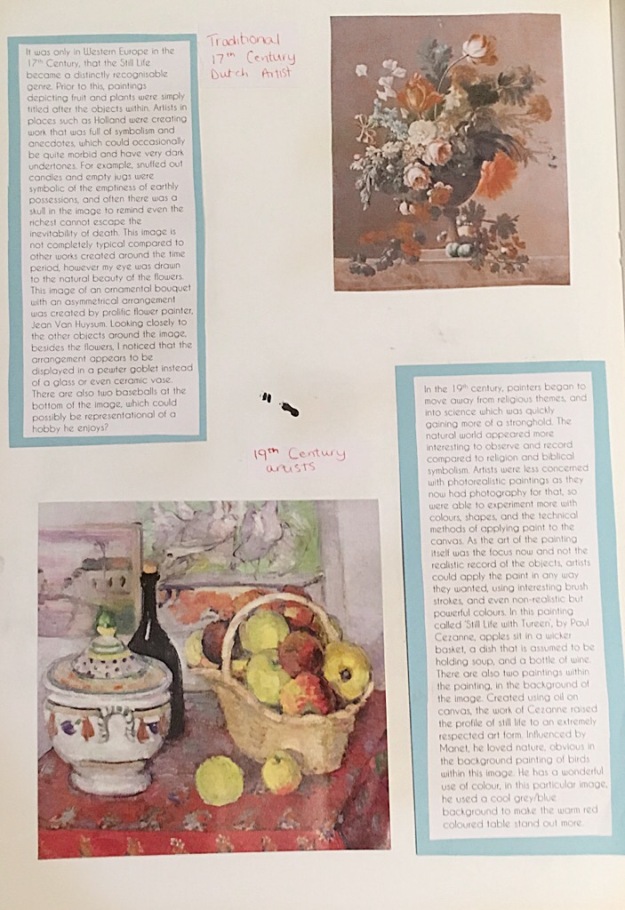I really enjoyed collecting images of still life paintings, and creating a double page spread in my sketchbook to document my research. 

(Transcript)
It was only in Western Europe in the 17th Century, that the Still Life became a distinctly recognisable genre. Prior to this, paintings depicting fruit and plants were simply titled after the objects within. Artists in places such as Holland were creating work that was full of symbolism and anecdotes, which could occasionally be quite morbid and have very dark undertones. For example, snuffed out candles and empty jugs were symbolic of the emptiness of earthly possessions, and often there was a skull in the image to remind even the richest cannot escape the inevitability of death. This image is not completely typical compared to other works created around the time period, however my eye was drawn to the natural beauty of the flowers. This image of an ornamental bouquet with an asymmetrical arrangement was created by prolific flower painter, Jean Van Huysum. Looking closely to the other objects around the image, besides the flowers, I noticed that the arrangement appears to be displayed in a pewter goblet instead of a glass or even ceramic vase. There are also two baseballs at the bottom of the image, which could possibly be representational of a hobby he enjoys?
In the 19th century, painters began to move away from religious themes, and into science which was quickly gaining more of a stronghold. The natural world appeared more interesting to observe and record compared to religion and biblical symbolism. Artists were less concerned with photorealistic paintings as they now had photography for that, so were able to experiment more with colours, shapes, and the technical methods of applying paint to the canvas. As the art of the painting itself was the focus now and not the realistic record of the objects, artists could apply the paint in any way they wanted, using interesting brush strokes, and even non-realistic but powerful colours. In this painting called ‘Still Life with Tureen’, by Paul Cezanne, apples sit in a wicker basket, a dish that is assumed to be holding soup, and a bottle of wine. There are also two paintings within the painting, in the background of the image. Created using oil on canvas, the work of Cezanne raised the profile of still life to an extremely respected art form. Influenced by Manet, he loved nature, obvious in the background painting of birds within this image. He has a wonderful use of colour, in this particular image, he used a cool grey/blue background to make the warm red coloured table stand out more.
Moving into the 20th Century, modern Still Life paintings dissolved into geometric abstraction. By now, the genre had evolved massively from its traditional roots in dark, shadowy and fundamentally realistic oil paintings. Whereas in the past they used mostly natural objects such as fruits and flowers, modern still life art uses plenty of manufactured items, often with a ‘pop art’ feel to it, for example using soup cans, televisions, boxes, and tools as the subject matter. These are chosen for their symbolic familiarity, and a lot of artists simplified these objects to create art that consisted of basic shapes and contradictions in scale. They also used a range of materials, from paint, to collaged mixed media, for example using coloured paper, strips of newspaper, wallpaper and oilcloth within these images. Compositionally, traditional pieces were very simplistic, often with just a table, wall, and objects positioned within, but in more recent compositions, especially when we look at work by the cubists, we see they incorporate multiple viewpoints, irregular shapes and an abstract finish. For example, a tables legs may be drawn as if seen from the side, but the tabletop may be drawn as if seen from above. In this image by Picasso, two bananas sit on a table with a glass, a plate of fruit, a wine glass, and a whole host of other abstract shapes and forms. Unique and interesting to the eye, it holds your attention and your eyes work to fill in the blanks, making it a piece you could look at time and time again and still find something new in it.
This final image is by artist Holly Boruck, who has created a unique still life that again commits to the simplistic geometric art style, but has a single viewpoint instead. The shapes and colour pallet appears neutral and subtle at first, but it has a lot of creativity within. There are mostly single tones of colour, but also vertical lines on the wallpaper, a thick line across the page to separate the top and bottom third of the image, and a much darker, gradiented colour for the table, with criss-crossed diagonal lines with dots in the middle. There is also a variety in line depth around the objects, the objects closer to the front of the table have thick outlines whereas the further back they are, the thinner they get. This creates a subtle illusion of depth. If I were to change anything about this image however it would be the composition, I would move the far right vase/jug and place it next in the middle.